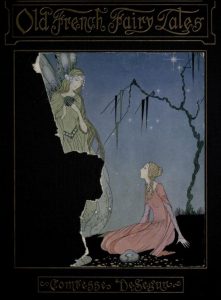Old French Fairy Tales – Comtesse de Segur
This beautiful book contains a group of fairy tales redolent of the charm of the seventeenth century, told with that delicacy so characteristic of the French. The illustrations, by Virginia Sterrett, are unusual for their beauty and artistic finish. The fairy tales included are.
The Story Of Blondine
Good Little Henry
History Of Princess Rosette
The Little Grey Mouse
Ourson
Format: Paperback.
Old French Fairy Tales.
ISBN: 9783849690205
Available at amazon.com and other venues.
Biography of the Comtesse de Segur (from Wikipedia):
Her father Count Fyodor Rostopchin was lieutenant-general and, later, Minister of Foreign Affairs for Russia. In 1812, he was governor of Moscow during the invasion of the Grande Armée under Napoleon I of France. While facts concerning the origin of the great fire of Moscow are disputed by historians, Sophie Rostopchine’s father has been said by some to have organized (despite opposition from the wealthy property-owners in the city) the great fire which forced Napoleon to make a disastrous retreat.
In 1814 the Rostopchine family left Imperial Russia for exile, going first to the Duchy of Warsaw, then to the German Confederation and the Italian peninsula and finally in 1817 to France under the Bourbon Restoration. In France, the father established a salon, and his wife and daughter converted to Roman Catholicism from Russian Orthodoxy.
It was in her father’s salon that Sophie Rostopchine met Eugène Henri Raymond, Count of Ségur (Fresnes, Seine-et-Marne, 12 February 1798 – Château de Méry-sur-Oise, 15 July 1869), whom she married on 13/14 July 1819. The marriage was largely an unhappy one: her husband was flighty, distant and poor (until being made a Peer of France in 1830), and his infrequent conjugal visits to their château des Nouettes (near L’Aigle, Orne) produced eight children, including the father of the historian Pierre de Ségur (Eugène de Ségur is said to have called his wife “la mère Gigogne”, or “Mother Gigogne” in reference to a theatre character of 1602, an enormous woman out of whose skirts a crowd of children appeared).
The Comtesse de Ségur wrote her first novel at the age of 58.
(The text of the last section was taken from a Wikipedia entry and is available under the Creative Commons Attribution-ShareAlike License.)
Publisher’s Note: This book is printed and distributed by Createspace a DBA of On-Demand Publishing LLC and is typically not available anywhere else than in stores owned and operated by Amazon or Createspace.

